Order Araneae Family Araneidae Higher classification Orb-weaver spider | Scientific name Mastophoreae Rank Tribe | |
 | ||
Similar Orb‑weaver spider, Arachnid, Cladomelea, Ordgarius magnificus, Araneus pentagrammicus | ||
Bolas spider
A bolas spider is any of several species of orb-weaver spider that, instead of spinning the typical web, hunt by using a sticky 'capture blob' of silk on the end of a line, known as a 'bolas'. By swinging the bolas at flying male moths or moth flies nearby, the spider may snag its prey rather like a fisherman snagging a fish on a hook. Because of this, they are also called angling or fishing spiders (although the remotely related genus Dolomedes is also called a fishing spider). The prey is lured to the spider by the production of up to three pheromone-analogues.
Contents
- Bolas spider
- The bolas spider that hunds by lassoing its prey
- Description
- Systematics
- Distribution
- Hunting
- Mastophora hutchinsoni
- Variations
- Droplet anatomy
- Reproduction
- Natural enemies
- Species
- References
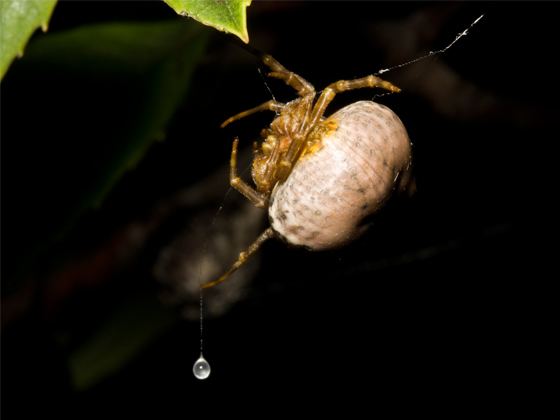
The bolas spider that hunds by lassoing its prey
Description
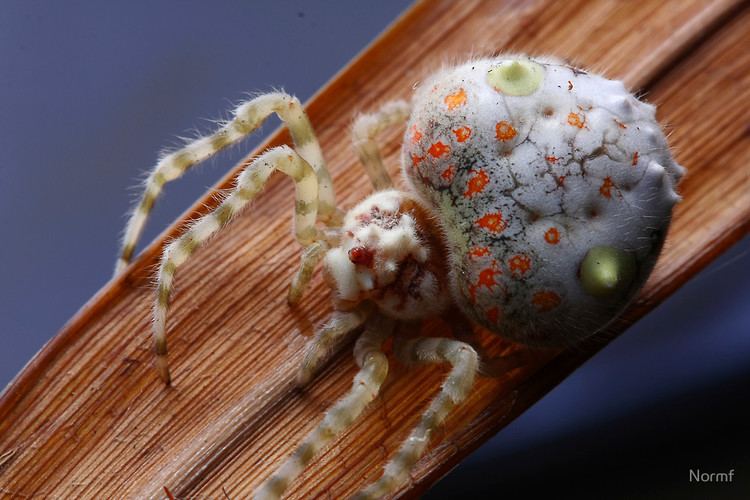
Bolas spiders are small nocturnal animals with oddly 'lumpy' abdomens. Females may grow up to 15 mm or 1/2", while the males, which are smaller, measure in at about 2 mm or 1/16". Several Mastophora species (e.g. M. cornigera) look like bird droppings, which enables them to rest unnoticed at day in fairly exposed places. M. bisaccata resembles the shell of a snail that is abundant in the spider's habitat. While the bird dropping mimics rest on the upper surface of leaves, M. bisaccata rests on the undersides. If removed from the surface, Mastophora females produce a pungent odor, which is highly unusual for spiders (other than bolas spiders, only one species of Cyrtarachne is known to do this). They do not attempt to flee when handled. Some species of Cladomelea also rest exposed on leaves during the day. However, the Australian Ordgarius magnificus, which displays eye spots on its back that make it resemble the moth they hunt, ties leaves together with silk to form a retreat. The females of some bolas spiders look remarkably like a bird dropping, thanks to their large, globular abdomen and brownish cephalothorax. This is a form of defensive mimicry as the animals that prey on spiders pay little attention to bird droppings.
Systematics
Bolas spiders are species of three related genera:
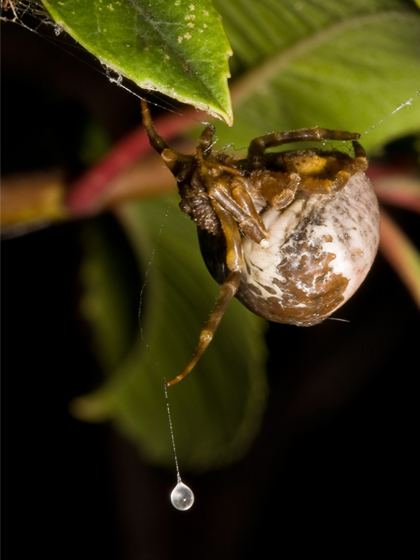
Traditional orb webs are not effective for capturing moths, because only their scales will stick, allowing the moth to escape. The ladder webs of Scoloderus species appear to be adaptations in web design to increase moth capture. These webs extend vertically about seven times their width. When a moth slides down the web, it leaves a trail of scales until its body sticks to the web. However, these spiders do not seem to be closely related to bolas spiders. The nearest relatives seems to be the Cyrtarachneae (e.g. Pasilobus) of the Paleotropics. They also specialize on moths, and use threads that are beaded with sticky droplets. Celaenia and Taczanowskia species in South America seem to use chemical attractants to catch moths, too, and may also be closely related to bolas spiders.
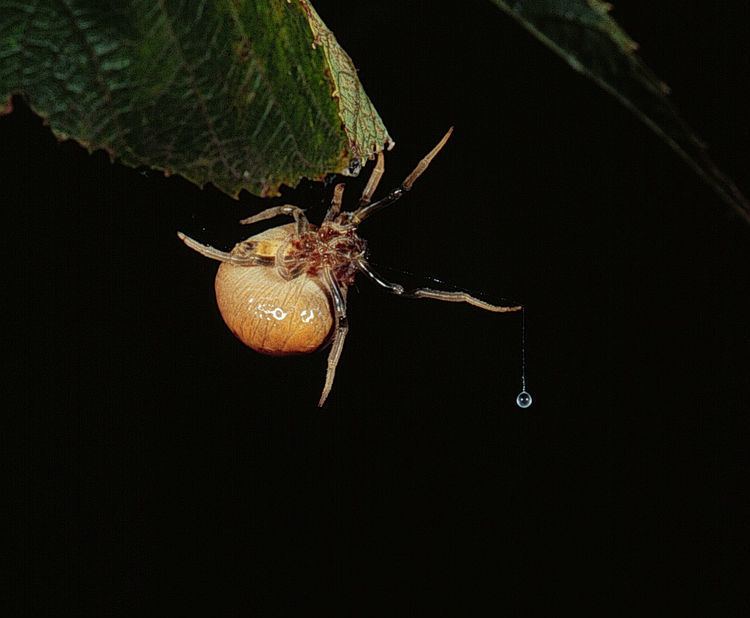
At least four Mastiphora species are known to sometimes, instead of preparing a single bola, to hang up to nine droplets on one horizontal line. This has not been observed to result in prey capture, but is remarkably similar to the midline of a Pasilobus web in which the low-shear joints of spanning threads have been broken.
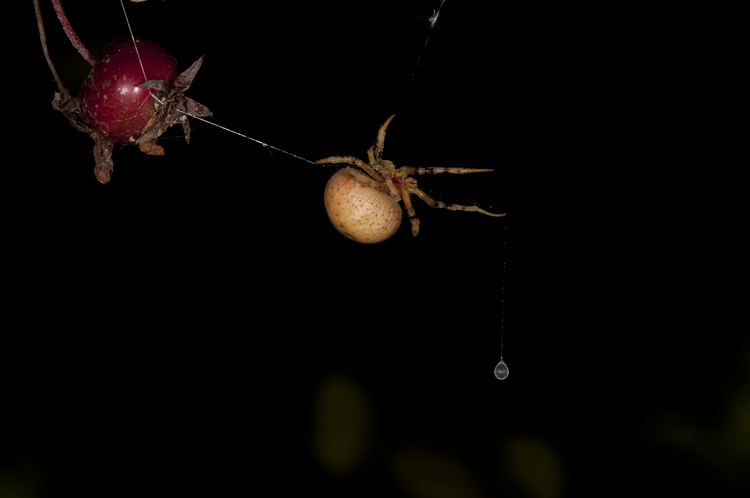
Interestingly, the not closely related araneid genus Kaira uses a pheromone very similar to Mastiphora to catch moths, however it does not use a bola, but instead catches the insects with a basket formed from its legs.
Distribution
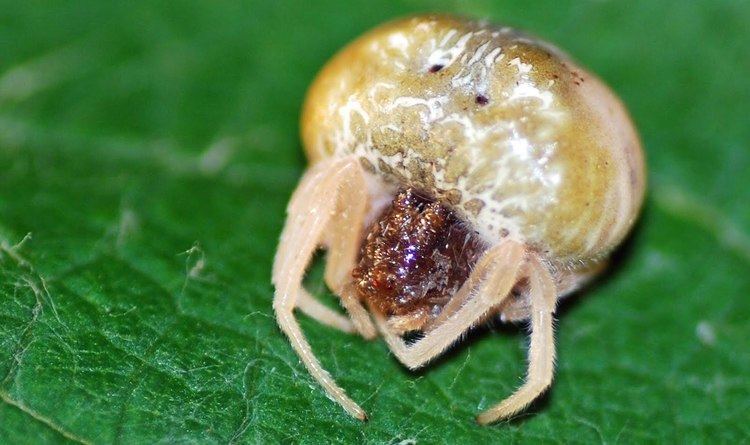
Members of this group are found in America, Africa, and Australasia. They do not occur in temperate Eurasia. About half of the known Mastophora species occur in South America. The genus is distributed from southern Chile to the extreme northern US (to 45° north latitude in Minnesota). M. archeri, M. bisaccata, M. hutchinsoni and M. phrynosoma occur widely in the US east of the Great Plains. M. cornigera occurs from Alabama to California, as well as in northern Mexico.
Hunting
Every spider species produces the pheromone of only one specific moth species (or a small set) and is thus dependent on it. However, bolas spiders will try and often succeed to catch any insect that is flying nearby, aided by their good eyesight. They also seem to detect prey by the sound of their approaching flight.
Spiderlings and adult males hunt without a bolas. This might be because the small globule these spiders could produce would dry out rapidly. Rather, they position themselves at edges of leaves and grab prey with their frontal pair of legs. Moth flies of the genus Psychoda are prominent prey in juvenile and adult male Mastophora. Adult spiders consume the bolas after at most half an hour if the hunt was fruitless.
Female Mastophora catch an average of two moths per night, but as many as six or seven catches during a single night have been observed.
Mastophora hutchinsoni
The species Mastophora hutchinsoni preys exclusively on the males of a few moth species. Its major prey is Lacinipolia renigera. A study by K.F. Haynes (University of Kentucky) showed that the spider adapts to the change in prey availability: One prey species flies from the early evening until 10:30pm, the other only after 11:00pm. The first moth ignores the pheromone of the second, so the spider produces a mix of both pheromones early in the evening. However, since the second moth is repulsed by the other moth's pheromone, the spider ceases to produce the first pheromone later at night.
Variations
The manner in which the bolas is swung differ between the three genera. Mastophora holds the bolas stationary with a front leg until a moth approaches, and then cocks the leg and swings the bolas towards the prey with a rapid pendulum-like stroke. Ordgarius begins to whirl the bolas rapidly when detecting an incoming moth. Cladomelea akermani whirls the bolas immediately after it is prepared for about 15 minutes, even when there is no moth present. Ordgarius sometimes has smaller droplets above the terminal one, whereas the other genera produce only one terminal globule.
Droplet anatomy
Droplets are about 2.5 mm in diameter. The internal structure is complex, consisting of a mass of curled or folded fibre embedded in a viscid matrix which is in turn surrounded by a less viscous layer. This results in the low viscosity liquid flowing past the moth's scales to reach the cuticle below, while the more viscous liquid forms a bond to the thread to sustain the moth's weight. The folded thread inside the ball permits elastic elongations which extend the spider's striking range.
Reproduction
Bolas spiders mate in late summer. In late fall, the female spider attaches several egg-sacs suspended in the vicinity of her retreat; each one is larger than herself and contains a few hundred eggs. Males emerge as reproductively capable adults.
Natural enemies
A gryllacridid was observed feeding on the eggs of O. magnificus, and a sarcophagid parasitoid has been reared from eggs of the same species. Five species of hymenopteran parasitoids are known to attack Mastiphora eggs. Tromatobia notator parasitizes M. cornigera, M. bisaccata and M. phrynosoma; Gelis sp. parasitizes M. cornigera. The eupelmids Arachnophaga abstrusa, A. ferruginea and A. picea parasitize Mastophora species, M. hutchinsoni and M. cornigera, respectively.
Species
Cladomelea Simon, 1895
Mastophora Holmberg, 1876
Ordgarius Keyserling, 1886
